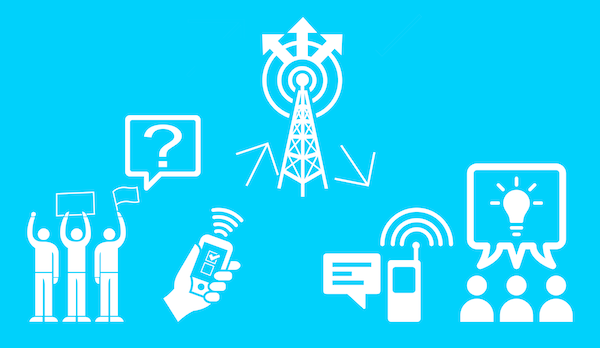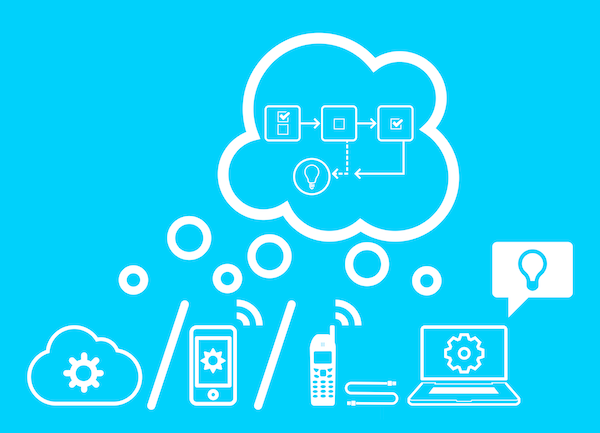Text messaging is more accessible than ever and can be a powerful tool in direct community organizing.

Is Text Messaging Right for Your Work?
Short Message Service (SMS) can be an effective method for communicating and interacting with a relatively large audience of supporters in a direct and engaging way. Despite their reputation for being exclusively the domain of large-scale fundraising – or even Stupid, Pointless, and Annoying Messages (SPAM) – mass text messaging services have great potential to be used in grassroots community organizing in a way that can greatly benefit your mission (and your community) in the long run.
Text messaging technology is old, simple, and cheap enough for it to have become by far the most widely adopted form of electronic communication, even in rural regions without internet connectivity. Even where coverage is too spotty for a phone call, a text message will always come through as soon as coverage becomes available. Because it requires only the most basic infrastructure, SMS is often the tool of choice for low-capacity and community-organized projects such as citizen reporting and journalism, connecting people with doctors and educators, allowing lending and payments over long distances, and providing farmers with agricultural price updates.
Just a few use-cases:
FrontlineSMS Projects: Legal advice, mobile payments, education
Hurricane Sandy Relief: Occupy SMS connects aid with those in need
Text Messaging boosts farmer incomes in India
Why Text Messaging Is More Powerful Than You May Think
Text messages are great for communicating with people on a closer and more informal level than is possible through e-mail or even a phone call, and it is far easier to actually engage your audience. Unlike most other forms of communication, text messaging is:
- Intimate/Direct
Unlike e-mail, where many people delete far more messages than they read, most people still read every text message they receive and keep the ones they need for later reference. Specifying distinct command words that your SMS service will recognize also makes it simple for recipients to reply as soon they receive a message (or later) if they are interested.
- Immediate
At a maximum of 160 characters per message, messages are small enough to be received a few seconds after they are sent.
- Always on, Everywhere
People who have a cell phone often carry it with them at all times, meaning they can be out and moving and still receive, read, and even respond to your message.
- Accessible
This applies both to the users/community members/constituents who subscribe to your messages, and to the experience of you and your organization. In the United States, 91% of adults carry a cell phone capable of text messaging. On top of that, it is cost effective to both send and receive text messages.

Text Messaging Services — The ‘Brains’ Behind the Operation
Clearly it’s not possible to text message every one of your contacts individually, let alone read and process all of the responses you receive, and group messages pose obvious privacy issues and require trust that no member is going to spam the rest of the participants (because you gave them their phone numbers).
So, what can you do, then?
There are countless tools that fall under the category of ‘SMS Services’. (Short Message Service Service — like ATM Machine, or PIN Number— is kind of redundant.) Each tool has the same set of core functions:
- Send/receive messages
- Manage contacts and groups of contacts
- Set up rules for how the service reacts to keywords and messages
The main differences between tools are that they vary heavily in:
- What is required to run it,
- Where it actually runs (both the service’s ‘thinking’—which can be a smartphone, a personal computer, or ‘cloud’ server— and its texting ability—which can be any phone [with cell service], a GSM modem, or ‘cloud’ server),
- Cost of messages and the service itself,
- Set-up (time and energy), and
- Scale.
While we won’t be addressing any specific tools here, at the end of this post we’ve included the set of tools we have tested and used in projects.
Use Responsibly
While SMS is possibly the most effective way to reach out to people you are trying to support through your work, if used irresponsibly —which is easy to do without meaning to— you risk alienating your community and supporters (making them former supporters) and can breach into the realm of becoming illegal SPAM. We want to help you avoid doing that and also make sure your supporters feel comfortable participating by maintaining the following:
- Consent
In order to send multiple messages to a person, you must earn their consent to do so. If you have a list of participants for one of your events and their phone numbers, you are allowed to send out a blanket text message offering instructions TO consent if they choose. If they do not respond, you cannot send them any additional text messages. After consent is earned, it’s always good practice to respond to their consent with clear instructions to withdraw their consent at any time. This way they won’t feel trapped!
- Content, Tone, and Frequency
Content: It shouldn’t come as a surprise, but people who consent to receive a particular type of information (example: upcoming events) usually only want to receive that type of information. Messages should be as brief as possible to address the major topic of your message. Don’t make them read a whole paragraph! If you are communicating several types of information, you should also provide ways for your audience to opt in to each type.
Tone: When you’re talking to humans about human things, it’s perfectly appropriate to talk like a human. If you want to ask people if they are planning on attending an upcoming event, ask them like you would normally, but ask for specific responses to communicate ‘yes’, ’no’, or ‘maybe’ so your service can read it and make it useful for you. People feel more comfortable responding to a message when they feel like it comes from a community member rather than a bank!
Frequency: Messages should be consistently spaced and as infrequent as possible to communicate your goals. An even better practice would be to provide a way for your audience to change options for how often they receive your messages, so they know when to expect them.
- Privacy
There are two reasons for maintaining the privacy of your contacts: 1) To protect them by allowing them to respond (relatively) anonymously, and 2) So they do not feel that if they DO opt in, they are going to receive messages from third parties or other contacts.
In some cases, being found to be associated with your cause may put supporters at risk — for example: if your community consists of undocumented workers, you MAY not want their identities known. Additionally, participant-to-participant communication might actually be a legitimate short-term use, if personal information about participants is concealed by your service.
Getting Started
Questions to consider when choosing a service:
- Who is my audience? How large?
- How do I collect contact information from participants?
- What do I need the service to do?
- What do different services require or cost?
- How do I maintain the privacy of participants?
- Do I need to be able to change the service in real-time?
Here is my rough guide to help decide which service might be appropriate for your specific use [PDF]
Resources
Below are the tools I have tried, and my assessments of many of them here [PDF]
For further reading check out Tactical Tech’s Mobiles-in-a-Box: Tools and Tactics for Mobile Advocacy
Creative Commons Attributions: Arrows designed by Tobias Klepp, Share designed by Anand A Nair, Protest designed by Gilad Fried, Cell Phone designed by Alex Hartmann, Cloud Settings designed by Agus Purwanto, Laptop designed by Olivier Guin, Light Bulb designed by Ema Dimitrova, Settings designed by Joe Mortell, Tips designed by Lemon Liu, Thought Bubble designed by Irene Hoffman, Radio Tower designed by Jon Anderson, NFC Phone designed by Andrew Forrester, Comment designed by Icomatic, Iphone designed by Hedie Assadi Joulaee, Signal designed by Alex Fuller.
All other glyphs fall under Public Domain from the Noun Project.








Recent Comments